|
The Canadian
Snowbirds were born out of the seed planted by the Golden
Centennaires. Colonel O.B. Philp, the commanding officer of the
Centennaires, became the base commander at CFB Moose Jaw. Col.
Philp wanted to ensure that the traditions of aerial perfection
established by teams such as the Golden Hawks and his own Golden
Centennaires were not lost. So, he established an unofficial
"formation" team at Moose Jaw, Saskatchewan in 1971.
The helmets used
by the early teams were based on the Gentex DH41 series
introduced to the RCAF in the early 1960's. The DH41 helmet was
a unique close-fitting helmet, similar to an armourer's or
tanker's helmet. It had a white fibreglass shell and a red
coloured liner helmet. The liner acted as the communication
platform as well as a platform to secure the oxygen mask. The
liner had two basic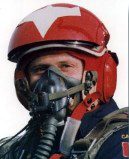 configurations. The first was a liner completely covered by red
cotton material. The second configuration was designed for
pilots who could not fit a standard-sized liner. This liner was
made of the same red cotton material but had two large openings
at the ear position. Large ABS plastic earcups used to house the
earphones were integrated right into the liner. While their
natural colour was white, the Snowbirds painted the earcups red
to match the liner.
configurations. The first was a liner completely covered by red
cotton material. The second configuration was designed for
pilots who could not fit a standard-sized liner. This liner was
made of the same red cotton material but had two large openings
at the ear position. Large ABS plastic earcups used to house the
earphones were integrated right into the liner. While their
natural colour was white, the Snowbirds painted the earcups red
to match the liner.
For the 1971 and
1972 teams, the aircrew helmets were painted red with a 5 inch
wide, white stripe painted down the centre. Within the white
stripe were red maple leaves. These leaves were painted down the
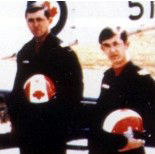 centre
with the stems pointing towards the back. There were usually
three, sometimes four leaves. The edging of the helmet was black
and the helmet had a snap-on visor that operated via two
external hinges that were secured to the helmet with screws and
self-locking nuts. The visor was protected with a chamois cover.
The pilot's name was painted on the chamois in red. The type was
Old English script. Team lead Major Glen Younghusband used a
variation of the DH41 helmet. Major Younghusband's helmet was
painted identically to the snap-on visor helmets but instead of
a chamois visor cover, a SPH-3 dual visor kit was added. His
name was painted in red on the plastic visor cover in the same
Old English script. centre
with the stems pointing towards the back. There were usually
three, sometimes four leaves. The edging of the helmet was black
and the helmet had a snap-on visor that operated via two
external hinges that were secured to the helmet with screws and
self-locking nuts. The visor was protected with a chamois cover.
The pilot's name was painted on the chamois in red. The type was
Old English script. Team lead Major Glen Younghusband used a
variation of the DH41 helmet. Major Younghusband's helmet was
painted identically to the snap-on visor helmets but instead of
a chamois visor cover, a SPH-3 dual visor kit was added. His
name was painted in red on the plastic visor cover in the same
Old English script.
Unlike many other
military air demonstration teams, the Snowbirds do not have
support aircraft to move their equipment and ground crew. The
team is totally self-contained with 11 tutor aircraft. Ground
crew fly with the team from show to show. In 1971 the ground
crew used the same DH41 helmet with the snap-on visor and
chamois visor cover. Ground crew helmets were painted white but
their names did not appear on the visor cover.
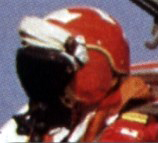 In
1973, the Canadian Air Force adopted the DH41-2 flying helmet.
This helmet was basically a standard DH41 with a C2308 dual
visor kit. The DH41-2 helmet incorporated a mechanism that
required the pilot to raise or lower the visor by pressuring and
sliding one of two control buttons on the side of the helmet;
one button for the sun visor and another for a clear bird
protection visor. New team lead Major George Miller felt that
this procedure was a safety hazard for team members and the DH41
helmet with the single snap-on visor was retained. However, a
new paint scheme was introduced in 1973. The helmets were
painted red with 3 white speedbirds and a diamond down the
center. The diamond started at the back and contained the pilot
's position number. Then the speedbirds started small from the
back and increased in size to the front. White helmet edging
replaced the black edging of earlier helmets. The chamois visor
covers were identical to the previous years. In
1973, the Canadian Air Force adopted the DH41-2 flying helmet.
This helmet was basically a standard DH41 with a C2308 dual
visor kit. The DH41-2 helmet incorporated a mechanism that
required the pilot to raise or lower the visor by pressuring and
sliding one of two control buttons on the side of the helmet;
one button for the sun visor and another for a clear bird
protection visor. New team lead Major George Miller felt that
this procedure was a safety hazard for team members and the DH41
helmet with the single snap-on visor was retained. However, a
new paint scheme was introduced in 1973. The helmets were
painted red with 3 white speedbirds and a diamond down the
center. The diamond started at the back and contained the pilot
's position number. Then the speedbirds started small from the
back and increased in size to the front. White helmet edging
replaced the black edging of earlier helmets. The chamois visor
covers were identical to the previous years.
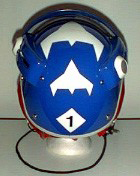 The
ground crew switched to the dual visor DH41-2 in 1973. Their
names and ranks were super-imposed in red over a white maple
leaf outlined in red, flanked by 3 speedbirds and a diamond. The
diamond was also in red. The
ground crew switched to the dual visor DH41-2 in 1973. Their
names and ranks were super-imposed in red over a white maple
leaf outlined in red, flanked by 3 speedbirds and a diamond. The
diamond was also in red.
There were no
changes for 1975 but in 1976 the ground crew helmets were
painted blue. In addition, the same combination of three white
speedbirds and a large diamond was used. The ground crew's
position number was located inside the diamond.
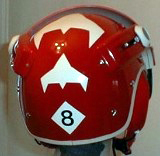 By
1977 aircrew had adopted the dual visor DH41-2 helmet. The
helmet was painted red with the same design of 3 speedbirds and
a diamond. This helmet and paint design was used until the 1989
season. By
1977 aircrew had adopted the dual visor DH41-2 helmet. The
helmet was painted red with the same design of 3 speedbirds and
a diamond. This helmet and paint design was used until the 1989
season.
However, there
were two known variations during the period leading up to 1989.
Major George Hawey was team lead for the 1983-1984 seasons. Maj.
Hawey had an exchange posting flying RF-4C Phantoms from 1977 to
1980 and managed to persuade the USAF to let him keep his fitted
helmet. His helmet was a HGU-26/P type complete with the
camouflage tape. The camouflage tape was removed and Maj. Hawey
had the 3 speedbird paint scheme applied to this helmet. The
Gentex HGU-26/P helmet consists of a HGU-22/P shell with a
PRU-36/P dual visor cover.
In 1986, Captain
Don Brodeur joined the team as opposing solo. It is believed
that Capt. Brodeur 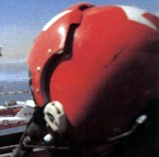 used
a Gentex HGU-55/P helmet with a single dark visor and an EEK-4A
visor cover. The same speedbird paint scheme was used. At that
time, the HGU-55/P and EEK-4A combination was also used by the
US Navy Blue Angels and the USAF Thunderbirds. used
a Gentex HGU-55/P helmet with a single dark visor and an EEK-4A
visor cover. The same speedbird paint scheme was used. At that
time, the HGU-55/P and EEK-4A combination was also used by the
US Navy Blue Angels and the USAF Thunderbirds.
1986 also saw the
introduction of the Gentex 190a helmet in to Canadian Air Force
service. The 190a is very similar in appearance to the HGU-55/P
helmet. However, there are some important differences. The 190a
employs the integrated chin and nape assembly. The visor stops
are twice as tall as those on the HGU-55/P. The face opening is
cut slightly higher on the 190a. And most significantly, the
centre leather patch on the 190a is much larger and resembles
more of an oval shape than the narrow leather strip on the
HGU-55/P. Many of the original features of the 190a are now
incorporated in the HGU-84/P helmet.
The Snowbirds
retained their DH41-2 helmets until the 1989 season. However,
photographic evidence indicates that 1987 team lead Major Dennis
Beselt used a 190a helmet during his two year tenure. Maj.
Beselt's 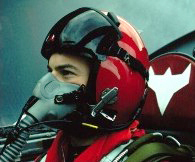 helmet
was as issued in its original combat grey paint. helmet
was as issued in its original combat grey paint.
It wasn't until
Major Dan Dempsey joined the team as team lead in 1989 did the
aircrew adopt the 190a helmet. The helmets were not painted red
but remained in the same issue grey paint. The visor cover was
made of red leather with chamois backing. A white leather
speedbird was sewn in to the visor cover. The ground crew
continued to use the DH41-2 helmet in 1989.
In 1990, both
aircrew and ground crew where issued the Gentex 190a. This
helmet continues in service with the team for its 30th
Anniversary. Aircrew helmets are painted red and ground crew
helmets are painted blue. There are three white speedbirds and a
large diamond down the centre, starting small from the back and
increasing in size to the front. The aircrew or ground crew
position number is located inside the diamond. The edging on
team helmets is black and the leather patches are completely
removed from the helmet. The Snowbirds use either a single
snap-on dark sun visor or a snap-on dual visor. The dual visor 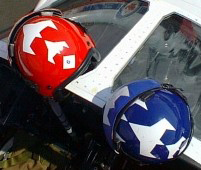 consists
of a clear bird protection visor and a dark sun visor. The
choice between using a single visor or a dual visor is a
personal preference. Some team members don't like to attach the
dual visors because they have to be careful to avoid scratching
the one visor while pulling down the other. When you are
travelling at 300 mph and and your wing tip is overlapping that
of another aircraft, worrying about your visor is the last thing
you need to think about. consists
of a clear bird protection visor and a dark sun visor. The
choice between using a single visor or a dual visor is a
personal preference. Some team members don't like to attach the
dual visors because they have to be careful to avoid scratching
the one visor while pulling down the other. When you are
travelling at 300 mph and and your wing tip is overlapping that
of another aircraft, worrying about your visor is the last thing
you need to think about.
In 1971 the team
started with a simple helmet with a snap-on visor. The Snowbirds
have come full circle, employing a simple helmet with a snap-on
visor. I hope you have enjoyed my look at Snowbird flight
helmets.
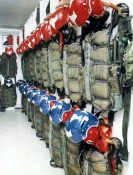
Sources:
Snowbirds, From the Beginning - O.B. Philp/Bill Johnson
Canada's Air Force Today - Larry Milberry
431 Air Demonstration Squadron 20th Anniversary Program
Flying High, Canada's Snowbirds Celebrate 25 Years
Snowbirds, Ambassadors of the Sky - Robert Mummery
CAF 431 Air Demonstration Squadron (Snowbirds) Website
|